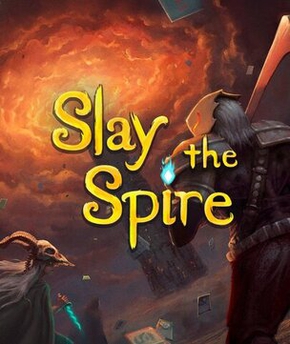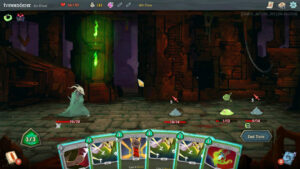
We don’t normally review video games on this site, sticking to the physical side of gaming. But it’s not unheard of and this week the game we’re looking at, “Slay the Spire,” could function as a physical game exactly as it does as a computer game. In fact, there will soon be a physical version of the game. Though, that looks to be a cooperative game, which will be a bit different.
Gameplay- A
The premise of the story is you are an adventurer, crawling through an enemy infested tower, seeking to kill the evil heart at the center. You move through an array of levels in three stages. Each level, you will either fight a monster, get a random event, get treasure, or find a merchant. You have a map with multiple paths to pick from. This is the part of the game that is best simulated by a computer. Each time you play, you get a random map. While you know what type of encounter you’ll face, each one is a random encounter. You could certainly reproduce this with a board and tiles, but it is a lot easier for a computer to do it for you.
 When you encounter monsters, you’ll need to fight them using a deck of cards. At its core, this is a deck building game. You start with a fixed deck consisting of several generic attack/defense cards and a few special cards specific to the hero you are playing. As you progress, you’ll gain new cards and have a few opportunities to remove weaker cards. The leaner you can make your deck and focus on synergistic, powerful cards, the better you’ll do.
When you encounter monsters, you’ll need to fight them using a deck of cards. At its core, this is a deck building game. You start with a fixed deck consisting of several generic attack/defense cards and a few special cards specific to the hero you are playing. As you progress, you’ll gain new cards and have a few opportunities to remove weaker cards. The leaner you can make your deck and focus on synergistic, powerful cards, the better you’ll do.
Combat consists of a series of rounds. You’ll draw a hand of five cards and then have a fixed amount of energy you can use to play those cards. Cards cost 0-5 to play, though very few cost 3+. Which is good because at the start of the game you only generate three energy per round. Once you’ve played your cards, you discard your hand and then the monster(s) takes a turn. The monster(s) will then take their turn.
You will know in advance what the monster is going to do on their turn. An icon shows over their head with the damage they’ll do or if they intend to defend or cast a buff/debuff. You won’t know the exact buff/debuff they’ll cast or the value of their defense, but you will for damage. This is very handy as it allows you to know exactly how much damage you need to block. There are numerous ways you could design a villain attack deck to simulate this. The trouble would be in volume. The game has a wide array of monsters, each with unique set of attacks and buff/debuffs. Each monster having its own deck of cards, on top of the large array of hero cards, makes this a beefy product.
Your hand of cards will be one of three types. Attack cards deal damage. Sometimes they have secondary effects as well, such as drawing more cards or generating a buff/debuff. Skill cards cover more of a variety than attack, but their most common function is to generate Block. Block is used to absorb incoming damage. If you have 10 Block and the enemy attacks for 12, you’ll prevent 10 and then only lose two hitpoints. On the other hand, if you have 12 Block and they do 10 damage, you’ll block all the damage, losing no hitpoints, but the remaining Block will fade at the start of your next turn.
Finally, you have Power cards. These cards provide an ongoing effect for your hero. They are some of the more valuable cards, partially because of their ongoing effect, and partially because once played they are no longer in your deck, making it smaller. Powers are another area where a computer is handy, it remembers what they all do every round so you don’t have to, but you could easily handle it yourself with the cards on the table to remind you.
At the end of fights (that you win; if you lose, you’re dead and the game is over), you’ll receive a bit of Gold, a chance to select a new card, and then sometimes a potion or relic. Potions are random drops of one time use items. They provide an effect similar to playing a card, but you can use them anytime without costing power. But since they are one time use, and you don’t get them all the time, you’ll need to plan when is the best opportunity. Also, you can only carry three, so no hoarding.
For new cards, you’ll get three options to pick from. The new card is added to your deck in all future combats. You can elect to skip getting a new card, which is a wise choice to make if the new cards don’t enhance your deck’s playstyle. An early mistake is always getting a new card and then having a giant deck, so your odds of drawing those powerful cards are low. The further you go, the greater the odds of getting the option to select more powerful cards.
Finally, we have Relics, which are powerful enhancements that you get from treasure chests and when defeating Elite or Boss monsters. They provide ongoing effects, much like Power cards, but are always in play. Additionally, each of the four heroes starts the game with a unique to them relic. These would be the most fiddly to do in a straight conversion to a physical game. Some of them have effects that happen after X number of attack cards have been played or some other variable you’d need to track. Many of the relics are simple, straightforward effects you could refer to via a card. But others would be aggravating.
The game is played over a series of three maps, with a boss at the end of each map. Monsters, and bosses, get progressively harder. If you defeat the final boss then you can slay the evil heart at the center of the spire you’ve been climbing. And then you’re promptly put to sleep and forget everything so you can do it all again next time you play.
Production- A
The game is a very solid experience, both in terms of mechanics and experience. The cards are well thought out so that all of them have a build where they are great yet can also be complete crap. Some are naturally better than others, but because of the random nature of how you get cards, you can’t guarantee which cards you’ll see during a run. Part of the game strategy is adapting to the cards you do see, more than it is building the perfect power combo.
The four heroes each feel unique and different from each other thanks to their starting relic and their card decks. Mechanically, you’re trying to do the same thing; take no damage and deal out a lot of damage. But each hero does this in a very different way, and require different strategies. The best part is that each hero has multiple strategies they can use depending on what cards and relics you find.
Theme- A
This is a dungeon crawler and the game leans into it. That’s the advantage of video games over physical games. Components can only take you so far for selling the theme. The background graphics set the scene. The monsters aren’t animated much but have a wide variety of styles. Once you’ve played a little bit, you can get a feel for what each monster is going to do.
Expansions- TBD
Nothing official but there are plenty of player created expansions and mods out there. New cards, new heroes, new monsters are all easy things you can imagine adding and expanding the game.
Conclusion- A
The replayability for this one is high, which is always a great selling point. A great game to get on your computer but also something that will translate well over to a physical game. I look forward to the launch of that version.

Wayne Basta
Latest posts by Wayne Basta (see all)
- X-Wing Tier List – Rebels - May 10, 2023

